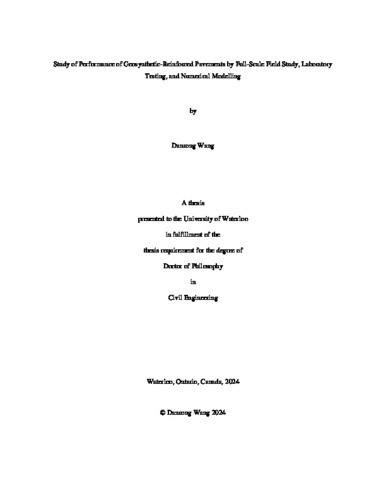| dc.description.abstract | This study provides a comprehensive understanding of geosynthetic-reinforced pavements from different perspectives including small-scale laboratory testing, a full-scale field study, and numerical simulation. This study on geosynthetic-reinforced pavements evaluated two geosynthetic materials: fibreglass geogrid in the asphalt layer; and geogrid composite at the interface of base and subgrade.
Fibreglass geogrid-embedded asphalt samples were made with three types of fibreglass geogrids – Geogrid 11, Geogrid 11 EPM (Engineered Polymeric Membrane) and Geogrid 10. The samples were tested with a conventional Hamburg Wheel-Tracking Test (HWTT) in a small-scale laboratory facility to evaluate the rutting and moisture susceptibility. The test outcomes indicate that Geogrid 11, characterized by larger openings, exhibits superior resistance to rutting. Conversely, Geogrid 10, with smaller openings, demonstrates lower susceptibility to moisture. Geogrid 11 EPM, featuring an additional adhesive membrane, exhibits the poorest performance in terms of both rutting resistance and moisture susceptibility. This suboptimal performance is attributed to the insufficient compaction effort, which further initiated another test proposed to evaluate the rutting resistance, namely the dynamic creep test. The proposed test was built upon the existing flow number test, with the stressed importance of extended testing protocols. The test results were analyzed with three major indicators, flow number, mean creep rate, and ultimate creep modulus, which highlight that fibreglass geogrid reinforcement plays a crucial role in enhancing resistance to permanent deformation, thereby increasing the asphalt's resistance to rutting. Results demonstrate a contrary conclusion with the HWTT, that Geogrid 11 EPM with larger openings but extra bonding provides the best rutting resistance. A less aggressive freeze-thaw (F-T) conditioning procedure was introduced to integrate with the dynamic creep test for geogrid-embedded asphalt samples to assess the impact of moisture damage on permanent deformation. The findings reveal that unreinforced samples consistently exhibit the poorest performance. In contrast, geogrids with larger openings and additional bonding demonstrate a capacity to mitigate the detrimental effects of moisture-induced damage.
The feasibility, constructability, and impacts of construction activities on pavements reinforced by these two types of materials were assessed during the construction of the field trial sections, and evaluated against an unreinforced control section. Post-construction field performance was monitored by field testing and instrumentation. Pavement stiffness tested by the Light Weight Deflectometer in the control section was notably influenced by ambient and pavement temperatures, indicating the effect of geosynthetic materials in preventing pavement stiffness from varying from temperature changes. Roughness measurements underline the need for an overlay of the surface course with geogrid reinforcement in the asphalt concrete layer. Truck testing further demonstrates the load-distribution capabilities facilitated by the fibreglass geogrid embedded in the asphalt layer. Field instrumentation was monitored for a year after construction completion, which demonstrates negative temperature differentials in the geogrid composite section during winter, indicating the effectiveness of the geogrid composite in regulating subgrade temperature and mitigating frost-related risks. Moisture data further illustrates relatively drier conditions in the geogrid composite section, underscoring its draining behaviour, particularly pronounced during thawing seasons. In the fibreglass geogrid section, a lower level of strain variation and pressure experienced at the bottom of the asphalt highlights the reinforcement capabilities and strain-absorption properties facilitated by the fibreglass geogrid. Additionally, the geogrid composite section exhibits lower strain and pressure on the subgrade compared to the control section, highlighting the reinforcing impact of the geogrid composite on the subgrade.
Lastly, pavement layer temperature predictive models with the input of ambient temperature were developed. A numerical model coupled with thermal-hydro-mechanical processes was created to simulate the pavement performance under freeze-thaw actions and examine the use of geogrid composite on the subgrade. The simulation from 2022 to 2023 using the developed model, with the input of pavement layer temperature predictive models and characterized field material properties, demonstrates less temperature variation in the subgrade, lower saturation levels, and reduced displacement after the thawing period in the geogrid composite section compared to the control section. This highlights the crucial role of the geogrid composite in drainage, subgrade temperature stabilization, and mitigating freeze-thaw disturbances in the pavement. | en |

